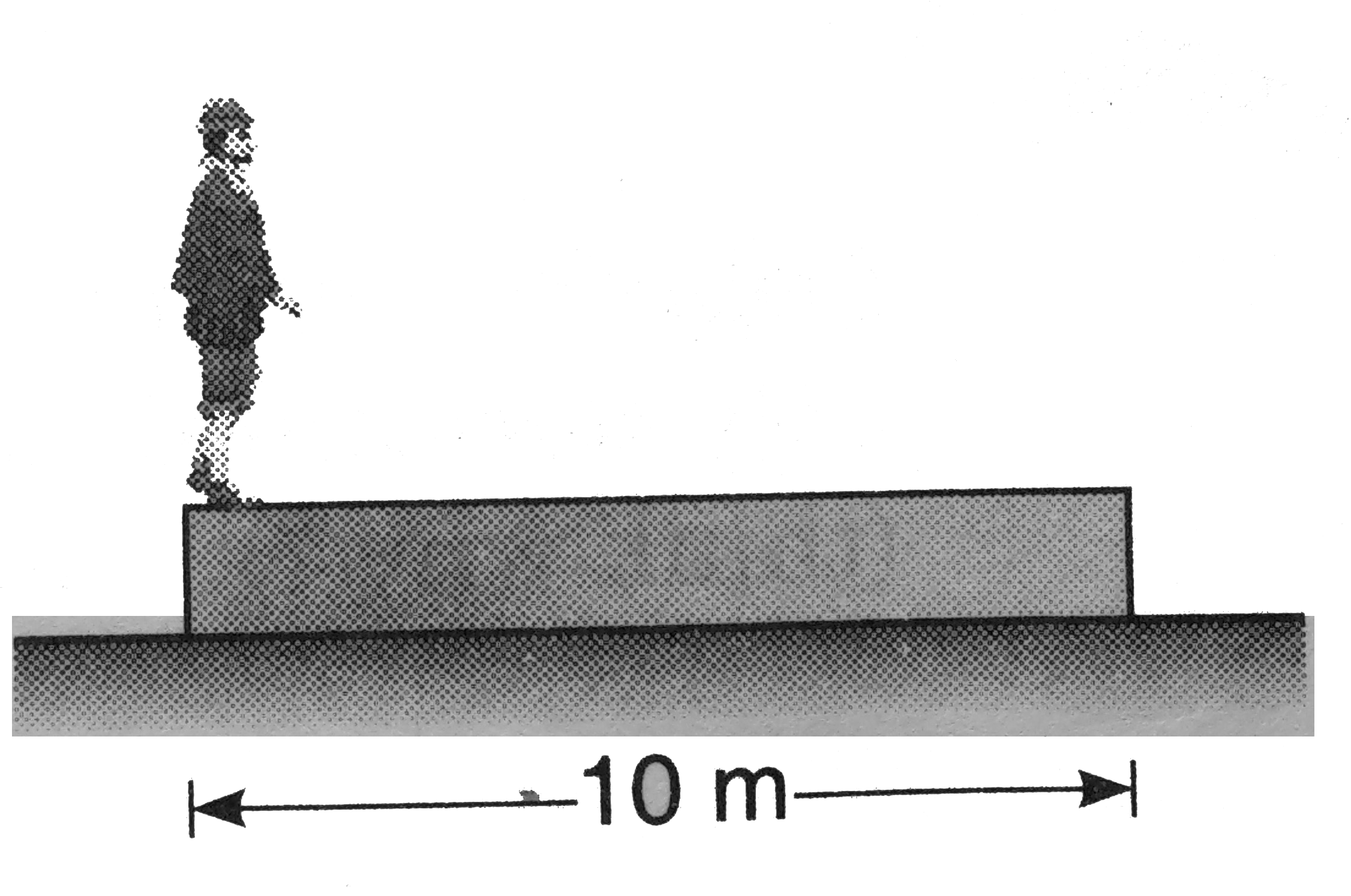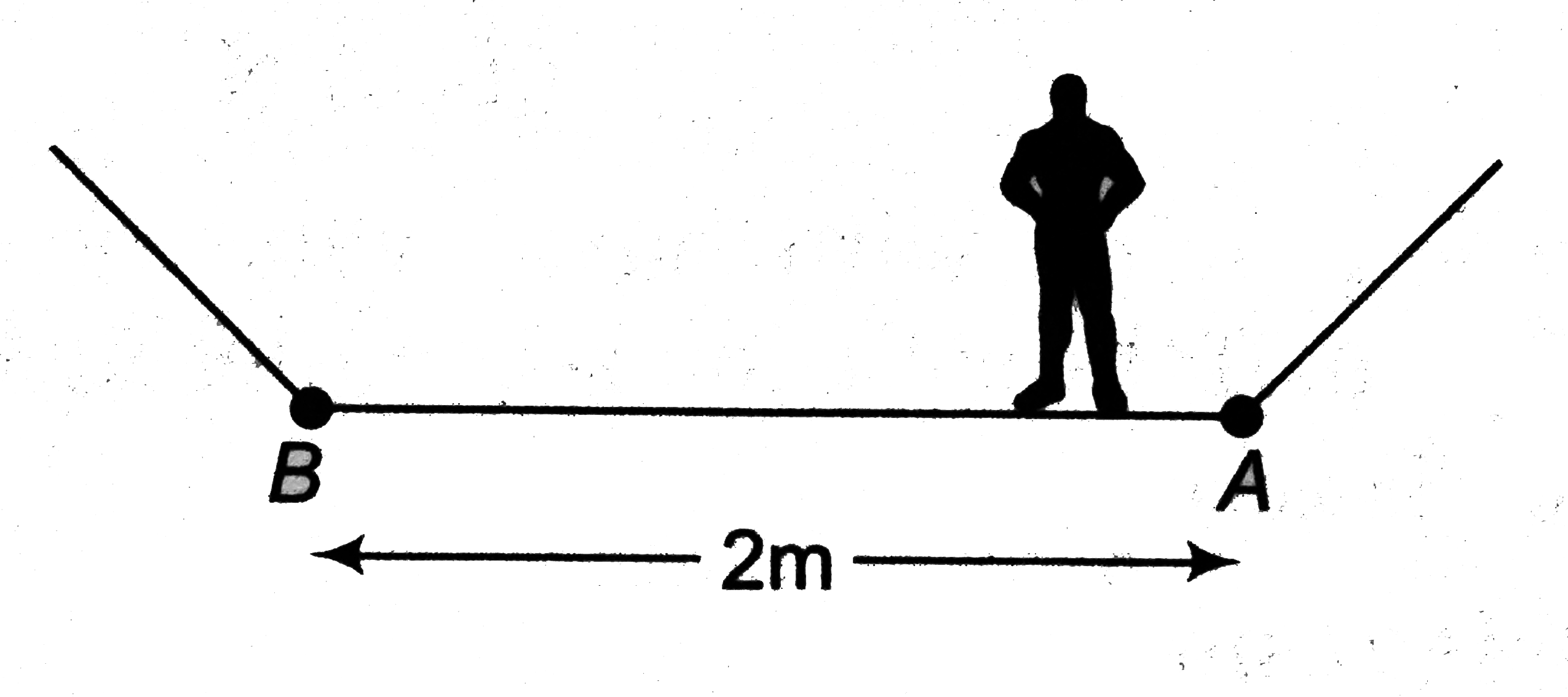A boat of mass 90 kg is floating in still water. A boy of mass 30 kg walks from one end to the other on it. If the length of the boat is 3 m, then the distance through which the boat will move is
0.45 m
0.65 m
0.75 m
0.25 m
To solve the problem, we need to determine how far the boat moves when the boy walks from one end to the other. We will use the principle of conservation of the center of mass.
1. Identify the masses and distances:
- Mass of the boat (m1) = 90 kg
- Mass of the boy (m2) = 30 kg
- Length of the boat = 3 m
2. Understand the system:
- The boy walks from one end of the boat to the other. As he moves, the boat will also move in the opposite direction to conserve the center of mass of the system (boat + boy).
3. Set up the center of mass equation:
- The center of mass (CM) of the system remains unchanged because there are no external forces acting on it.
- The position of the center of mass can be expressed as:
xCM=m1⋅x1+m2⋅x2m1+m2
- Here, x1 is the position of the boat, and x2 is the position of the boy.
4. Define the initial positions:
- Let's assume the boy starts at position x2=0 (one end of the boat).
- The boat's position can be considered as x1=0 initially.
5. Calculate the final positions:
- When the boy walks to the other end of the boat, his new position will be x2=3 m.
- Let the boat move a distance x in the opposite direction. Thus, the new position of the boat will be x1=−x.
6. Write the equation for the center of mass:
- Since the center of mass does not change, we can set up the equation:
90⋅(−x)+30⋅390+30=0
- This simplifies to:
90⋅(−x)+90=0
7. Solve for x:
- Rearranging gives:
90=90x
- Dividing both sides by 90:
x=9090=0.75 m
8. Conclusion:
- The distance through which the boat will move is 0.75 m.
- Mass of the boat (m1) = 90 kg
- Mass of the boy (m2) = 30 kg
- Length of the boat = 3 m
- The boy walks from one end of the boat to the other. As he moves, the boat will also move in the opposite direction to conserve the center of mass of the system (boat + boy).
- The center of mass (CM) of the system remains unchanged because there are no external forces acting on it.
- The position of the center of mass can be expressed as:
xCM=m1⋅x1+m2⋅x2m1+m2
- Here, x1 is the position of the boat, and x2 is the position of the boy.
- Let's assume the boy starts at position x2=0 (one end of the boat).
- The boat's position can be considered as x1=0 initially.
- When the boy walks to the other end of the boat, his new position will be x2=3 m.
- Let the boat move a distance x in the opposite direction. Thus, the new position of the boat will be x1=−x.
- Since the center of mass does not change, we can set up the equation:
90⋅(−x)+30⋅390+30=0
- This simplifies to:
90⋅(−x)+90=0
- Rearranging gives:
90=90x
- Dividing both sides by 90:
x=9090=0.75 m
- The distance through which the boat will move is 0.75 m.
Similar Questions
A wooden plank of mass 20kg is resting on a smooth horizontal floor. A man of mass 60kg starts moving from one end of the plank to the other end. The length of the plank is 10m. Find the displacement of the plank over the floor when the man reaches the other end of the plank.

View SolutionA boat of length 10m and mass 450kg is floating without motion in still water. A man of mass 50kg standing at one end of it walks to the other end of it and stops. The magnitude of the displacement of the boat in metres relative to ground is
View SolutionA uniform wooden plank of mass 150 kg and length 8 m is floating on still water with a man of 50 kg at one end of it . The man walks to the other end of the plank and stops. Than the distance covered by the plank is
View SolutionA man of mass 62 kg is standing on a stationary boat of mass 238 kg. The man is carrying a sphere of mass 0.5 kg in his hands. If the man throws the sphere horizontally with a velocity of 12 ms−1, find the velocity with which the boat will move (in magnitude)
View SolutionThe current velocity of river grows in proportion to the distance from its bank and reaches the maximum value v0 in the middle. Near the banks the velocity is zero. A boat is moving along the river in such a manner that the boatman rows his boat always perpendicular to the current. The speed of the boat in still water is u. Find the distance through which the boat crossing the river will be carried away by the current, if the width of the river is c. Also determine the trajectory of the boat.
View SolutionThe weight of a body of mass 6-0 kg on moon is 10 N. If a boy of mass 30 kg goes from earth to the moon surface, what will be his mass
View SolutionA boy of mass 30 kg is standing at one end on a stationary boat over a lake. The boat has a mass 70 kg and length 10 m. Now the boy walked to the other end of the boat. Relative to the ground
View SolutionA boy having a mass of 40kg stands at one end A of a boat of length 2m at rest. The boy walks to the other end B of the boat and stops. What is the distance moved by the boat? Friciton exists between the feet of the boy and the surface of the boat. But the friction between the boat and the water surface may be neglected. Mass of the boat is 15kg.

View SolutionA man of mass M stands at one end of a stationary plank of length L, lying on a smooth surface. The man walks to the other end of the plank. If the mass of the plank is M/3, the distance that the man moves relative to the ground is
View SolutionA man of mass M stands at one end of a stationary plank of length L, lying on a smooth surface. The man walks to the other end of the plank. If the mass of the plank is M/3, the distance that the man moves relative to the ground is
View Solution
